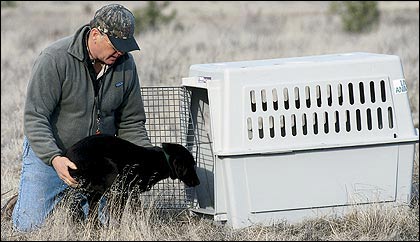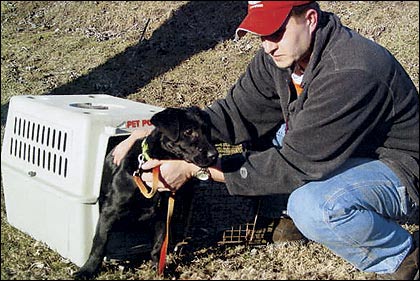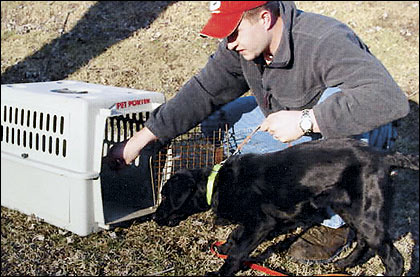Be firm with commands, praise frequently and discipline when necessary.
By Bob West
 As you begin teaching the kennel command, you actually push pup in as you "overlay" the cue/sound "kennel." |
In our last article we shared some ideas on puppy training centered around early socialization and getting a new puppy started correctly on the path to becoming a successful hunting or contest dog.
Let's continue, but with some emphasis on early training or yard work to be sure of a solid base as we move our "wonder dog" along.
Training
It is important to remember that in the beginning our pup has no idea of what's going on. With a mishmash of new sounds and pushing and pulling--none of which makes any sense--"training" can be downright confusing to a canine mind that's only a few weeks old.
Our first objective is to help the dog understand the parameters of this desired response in a positive way, being sure to avoid confusion as we define what is expected. Realize also, we're hoping to nurture a learning kind of mentality, setting the mode for future development.
During this learning phase of training, whenever possible most good trainers use an "avoidance" technique or approach to training, then once commands are learned, correction or punishment can be used to discourage disobedience.
Avoidance technique involves light pressure concurrent with the cue, which is released as the dog responds correctly.
A big benefit with avoidance training is that pressure or discomfort to the dog is more of a subtle irritation than clear pain. During learning, subtle pressure is less likely to overwhelm and "wash" any comprehension or inhibit progress because of fear of correction rather than focus on learning.
When using avoidance your dog will soon learn to escape the discomfort by a correct response, which is supported by praise and reinforcement from the trainer. And as training progresses your dog gains confidence along with an understanding that it is possible to totally avoid any discomfort by a quick response to commands.
| Related Content | 

Off To A Good Start: Part 1
|
|
So although it's not always possible, when we can we will use avoidance methods, and when not, a gentle blend of correction and praise to establish parameters and encourage the desired response. Only after we are certain commands are understood will we begin to elevate levels of distraction and reinforcement to ensure obedience in all situations.
Fundamental Commands
I have often said, "If he won't obey you on a four-foot lead, he'll surely not obey at 100 yards." So if your problem has been some macho misconception that this is sissy stuff, forget it. No matter what your goal--a companion housedog, a hunting partner or (if you're going for the gold ring and plan to field trial) a titled performance dog--it all starts the same.
No, Kennel, Heel, Sit, Come, Whoa
"No!" isn't a command we set up with specific drills to teach or enforce, like "Kennel"; it's learned early as a part of every day socialization and later reinforced in proportion to understanding to gain obedience.
"No" is a real command with only one meaning but endless uses; it simply means, "Stop it."
Teach No by consistently overlaying the word as a command when you stop pup from chewing your shoelace, from chasing the cat or from any other act you want him to quit and you'll be surprised how soon he understands and turns to you for direction and approval.
Don't forget praise for the correct response, but also realize this proof of understanding obligates you to stronger reinforcement when your pup chooses to disobey.
"No" and all the other commands become tools used throughout the dog's life. Proper use of each tool gains strength and effect as an accentual part in the building and handling of a working dog.
The reward is worth the effort. A time will come when you're able to stop the dog even before an action simply because the command "No" is in place and you've learned to read your dog's body language and expression to anticipate each move he makes.
 Never allow your pup to come out until released by you. Repeat "kennel" as you hold pup back, then release with "okay." |
Training basics are far more dynamic than sit and roll over; we're developing a working relationship, a learning mode, gaining a respect and understanding for each other€¦literally developing our foundation. Even at this point you should be able to see the importance and how a program without these fundamentals can't be strong.
Some good rules to follow are to never give a command you're not in a position to enforce and never fail to enforce the command once you've given it.
Caution: When reinforcing No, it's generally not a good idea to "pop" a young gun dog with a rolled newspaper as used to be recommended in many general training manuals. Your voice is sufficient; avoid the chance of your dog later associating the pop of a newspaper with the sound of a shotgun, which could result in gunshyness.
"Kennel," as we mentioned, is a command learned early. We begin by saying "kennel" when our new pup is put in his box for the night or after play, and we continue to overlay the command as he develops throughout life. As with any command, with understanding comes reinforcement to ensure obedience.
Kennel mean
s to pass through, go into or get up on whatever is indicated by our hand or arm gesturing. Again, it's a command with several uses but a single clear meaning. It's totally unnecessary to have individual commands for getting up on a table or entering a boat, truck, door, kennel, etc.
In training the command, it's important to remember that our dogs read body language better than we do, so use this to your advantage. When you give the Kennel command, help the dog understand. Use a little pressure at first, overlay the command and praise his correct response.
Your dog's crate is a good place to start. Run a lead through the crate from the back and out the open door, and then attach the lead to your dog's collar as he sits near the opening. As you give the Kennel command, have a friend tighten the lead to direct the dog in, and at the same time you might give your dog a pinch or swat on the rump with your hand, then praise him for going in.
 It won't be long before your pup understands the kennel command and responds correctly. Don't forget to reinforce with praise. |
It's important the dog remains kenneled until a release command is given, like "Okay." Never let your dog come back out on his own volition. If he tries, bump his nose with the back of your hand and repeat "Kennel." Kennel means to go in and stay in until released. Do not say "Kennel-Stay"; rather, keep it clean with one command per action.
Another idea as we expand the meaning of Kennel to include getting up on something is to use an ottoman or similar low, flat-topped object. This idea works especially well with young dogs.
| Related Content | 

Off To A Good Start: Part 1
|
|
Attach a short lead to his collar then call his name, command "Kennel" and pat the top of the low table or platform. A slight pull on the lead will not only direct your dog but will also help leverage his climb.
There's no problem with using an excited tone to help give your dog confidence, and don't forget the praise. Once he is on the table, reinforce with "Kennel" while being sure the dog remains in place until you release him with "Okay."
As always use your imagination to create other scenarios and opportunities to enhance training; be consistent and stick with it and you'll see results soon.
In following issues we'll continue our yard work with Heel, Sit, Come and a thorough discussion of the Whoa command.






